The Great Dane is a true gentle giant of the canine world. These are some of the biggest dog breeds, and they are also one of the kindest.
This Apollo of dogs has gained its nickname not just for its temperament, but also for its beautiful looks.
Indeed, the Great Dane breed is one of the most elegant-looking you can find. These large dogs have long legs, slim bodies, and cute faces, something that often connects them with Greek gods.
Another thing Great Dane dogs are known for is a large number of coat colors these pups can come in. Some of the most beautiful dogs out there are blue Great Danes.
Blue Great Danes are easy to notice due to their towering height and amazingly gorgeous bluish-grey coat color. They can truly make everyone at the dog park talk about them.
What makes these dogs so special?
If you’d want to learn more or are interested in becoming a blue Great Dane owner, this article is for you. I will explain all secrets about this unique coat color and the dogs that have it.
Let’s get started!
Standard Colors Vs Non-Standard Ones
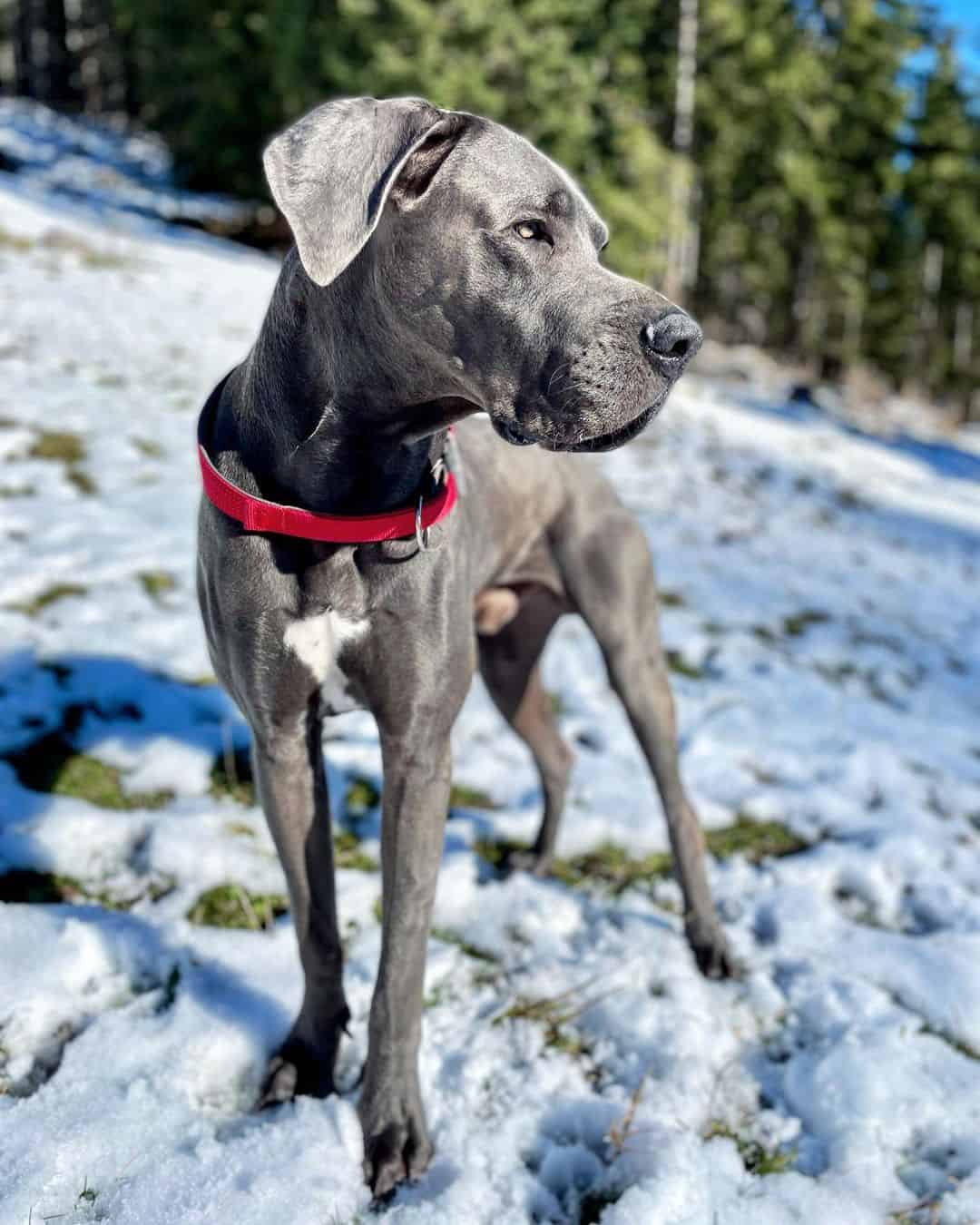
Photo from: @blue_great_dane_
Before we begin, it’s important to understand the standard and non-standard coat colors.
All dog breeds that have been registered by the kennel clubs, such as the American Kennel Club (AKC), the United Kennel Club (UKC), or the Federation Cynologique Internationale, have a specific breed standard.
This breed standard determines how the said breed should look and behave.
One of the things the breed standard regulates is the coat color of the breed. A dog can come in a coat color that isn’t recognized by the kennel club, but such a dog won’t be able to be registered, and some states might even forbid breeding such dogs.
So, what about Great Dane colors? Is blue Great Dane up to the breed standard?
The AKC recognizes ten Great Dane coat colors:
• Black.
• Black and white.
• Blue.
• Brindle.
• Fawn.
• Harlequin.
• Merle.
• Silver.
• White.
• Mantle.
This means that blue Great Danes are recognized by the AKC Great Dane breed standard.
However, some variations of the blue coat, such as blue and white or blue brindle, while recognized by the kennel club, aren’t considered a breed standard and are, instead, deemed as faulty.
Just because a dog comes in a non-standard color or in a color that isn’t even recognized by the kennel club doesn’t mean he’s a bad dog.
Standard coat colors have always been a part of the dog’s genetics, and they are considered desirable at dog shows.
Recognized but non-standard colors usually indicate that the dog, while purebred, isn’t that desirable within the show ring, and some of these colors might even be so rare that it’s impossible for them to be considered a standard.
If a color isn’t recognized, this usually indicates that the dog has either been mixed with some other dog breed, or the specific color is connected with some health issues due to which it was forbidden for further spreading into the breed.
Fortunately for you, blue Great Danes are widely accepted and very desirable, so such issues shouldn’t concern you.
Are Blue Great Danes Rare?
Blue Great Danes are not overly rare, although they are among the rarest accepted colors. Some patterns, such as blue harlequin, are considered rare, but blue as a color can be found in many Great Danes.
Still, they are far from common dogs, and they might not be as usual sight as some other coat colors, such as black.
Blue Great Dane Puppy
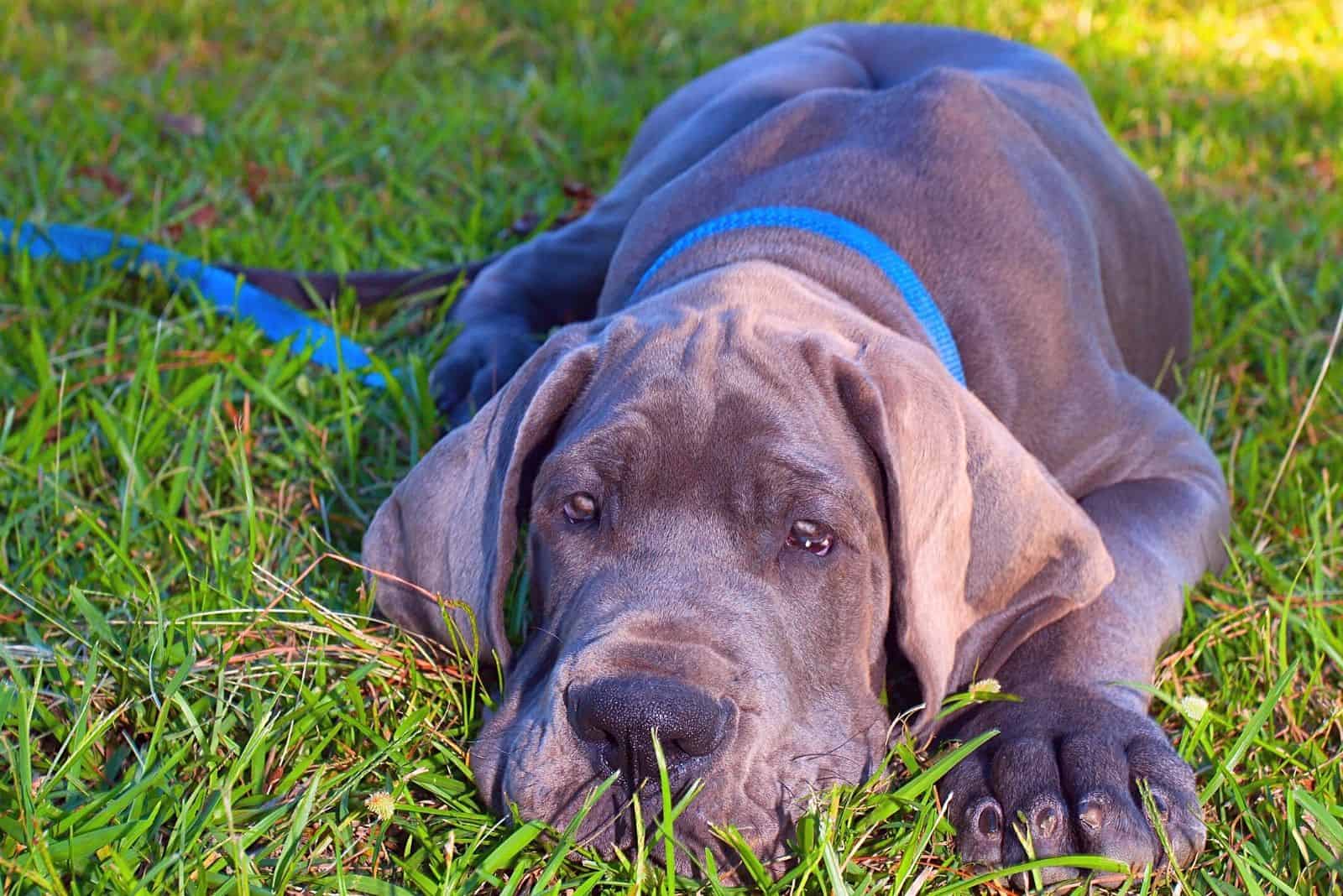
Blue Great Dane puppies are fairly rare, but they are not that challenging to find. Even breeders who specialize in other coat colors might end up surprised to find a blue puppy or two in their litters.
A general way of getting a blue Great Dane puppy is by breeding two blue Great Danes. However, as the blue coat color doesn’t necessarily have to be expressed in the dog, you might also get such a puppy if you breed a blue dog with a Great Dane of another color.
In fact, even two parents of entirely different coat colors might end up having a few of the blue puppies in their litter! I’ll explain the reasons behind this in a little bit.
As the blue color can be noticed in even the youngest puppies, it can be really surprising when you see a blue puppy being born to two chocolate parents.
Blue Great Dane Full Grown
Other than the coat color, the blue Great Dane looks the same as any other Great Dane. These are tall and big dogs that can reach the astonishing height of 32 inches. This makes them taller than even the most Mastiff breeds!
Great Danes are so tall that they would be taller than most people if they were to stand on hind legs. They are easy to recognize not just by their tall stature, but also by their goofy faces and floppy ears.
While most Great Danes come in part or merle patterns, blue Great Danes come in different shades of this solid coat color.
Blue Great Dane Genetics
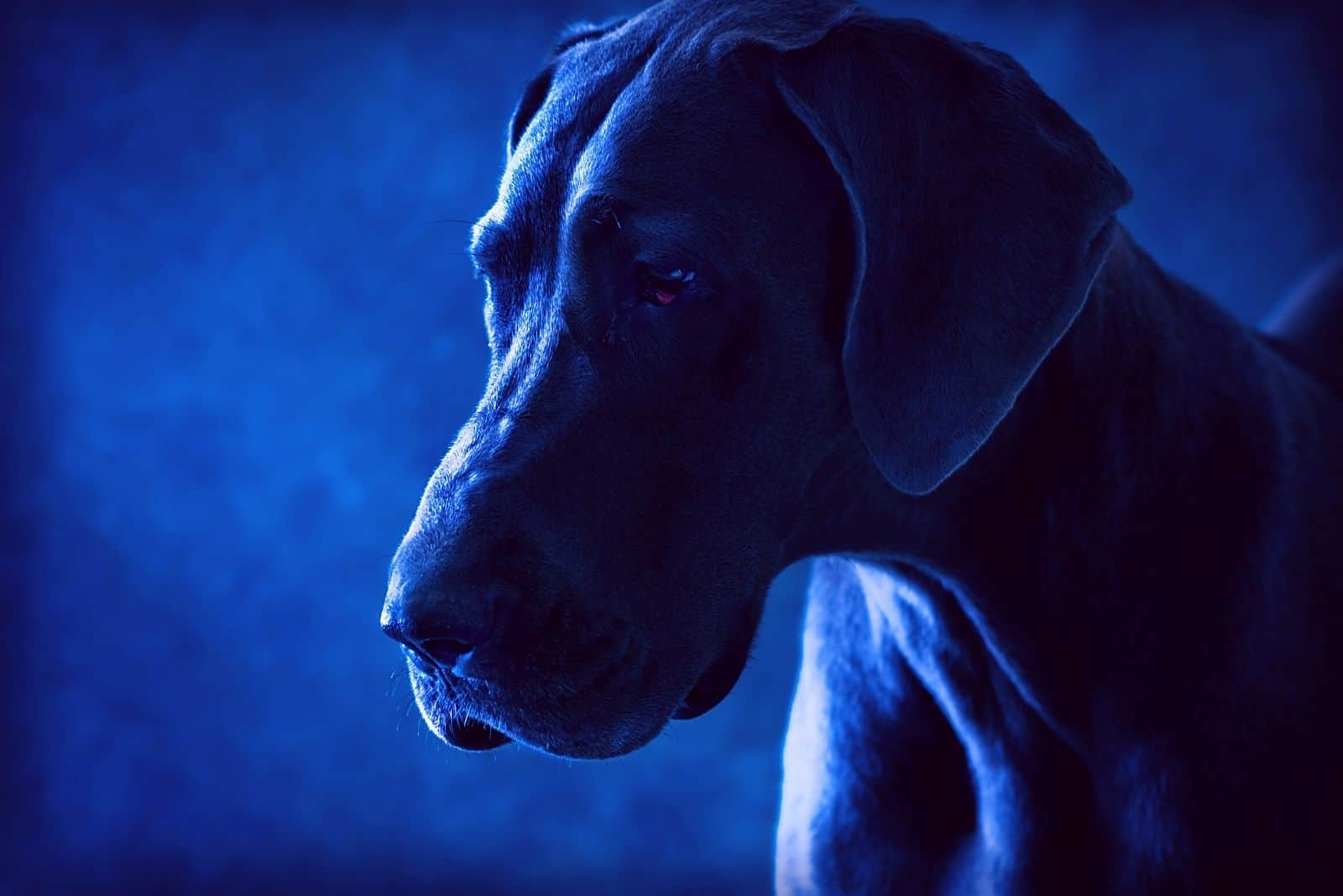
So, what makes blue Great Danes blue?
Everything about the dog’s appearance is caused by his genes. This includes his size, general looks, coat type, as well as coat colors.
There are two types of pigments in dogs: eumelanin, which is responsible for black colors, and pheomelanin, which causes red color.
The distribution of these coat colors is determined by a pair of genes – or rather, by alleles located on the responsible loci, a specific location on the chromosome.
Depending on the specific genes, your pup might have a brighter or duller coat color. For example, the amount of pheomelanin will determine whether the coat color will be mahogany, red, or golden.
White coat isn’t caused by any pigment, but rather the lack of it.
So, what about blue Great Danes?
Blue isn’t caused by a specific color gene, but rather by a dilution gene. This means that it isn’t exactly a pigment, but a dilution.
The blue dilution gene works together with the black color to create the gorgeous blue color you see on these pups. In other words, it dilutes the black coat, turning it into the blue-gray shade you can see on the coat.
This dilution is caused by a recessive gene, meaning that the dog needs to inherit it from both parents. Otherwise, the color won’t express itself and it will remain hidden.
In other words, a dog might be the carrier of this gene without being blue on its own. This is why two dogs of different coat colors can have blue offspring.
This isn’t the only dilution gene found in dogs. The other two common ones include the liver dilution gene and the merle gene – although the latter works quite differently.
How To Recognize Blue Great Danes
The recessive blue gene works only on the black pigment. If the dog doesn’t have a black coat, it won’t be born blue.
However, what this gene will affect is the nose and eye color of these pups.
All blue Great Danes will have blue noses, no matter the color of their coat. This is the easiest way to differentiate the dogs with the blue dilution genes from the others.
As such, you might have a cream blue Great Dane, a blue fawn Great Dane, and so on.
This isn’t specific to just blue Great Danes. This gene will equally affect any dog breed, from Pitbulls and Dalmatians to Dobermans and German Shepherds.
Blue Great Dane Colors
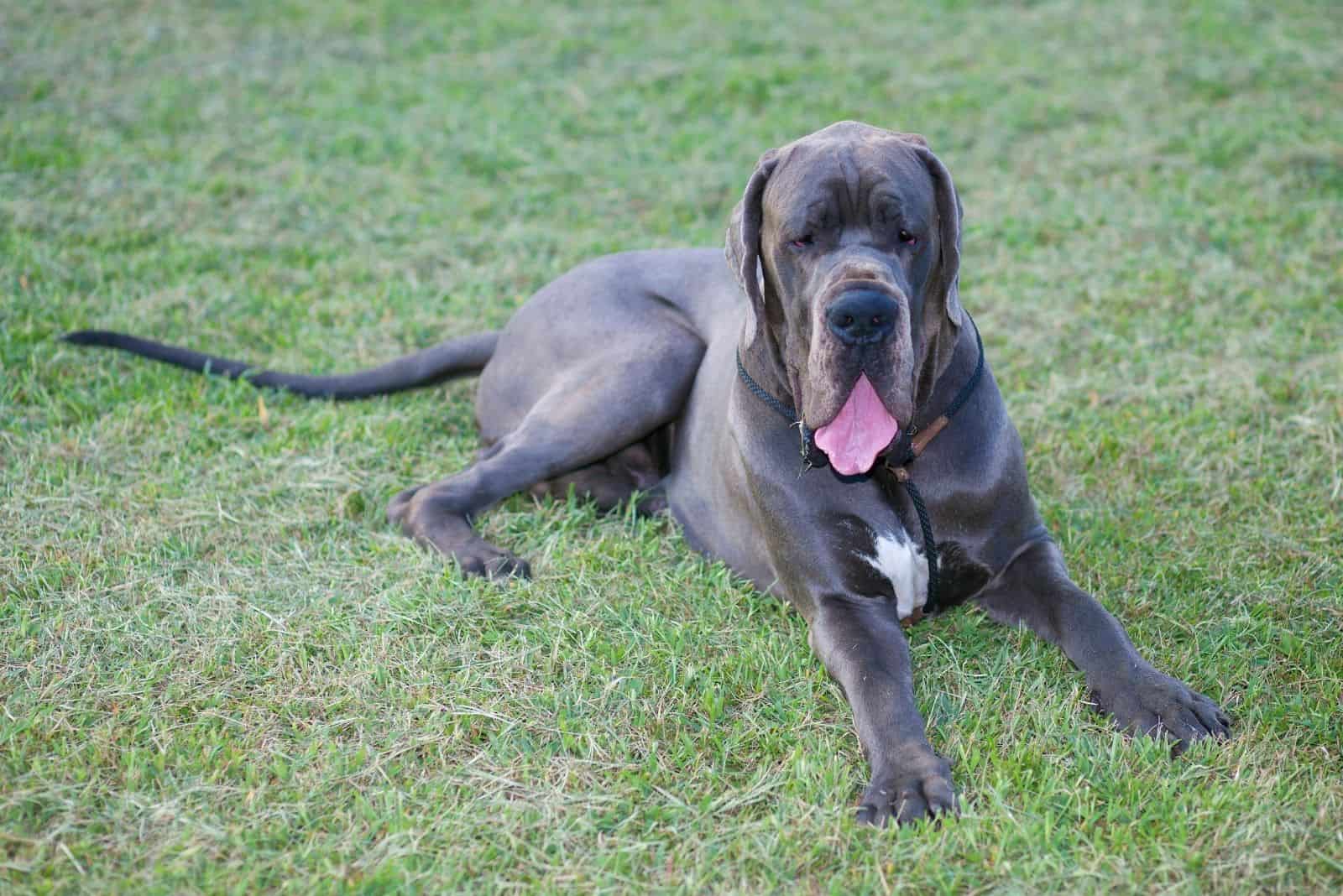
If you’re unfamiliar with the coat color names, you were probably surprised when you heard the phrase blue Great Dane. Dogs cannot really be blue, which is why this probably surprises you.
Blue coat color is, in fact, the term used to describe a specific shade of grey coat. These coats have a bluish tint to them, which is why they are called blue.
This tint is also how you can differentiate blue Great Danes from silver dogs. Silver grey is a much lighter shade that is usually pure grey. Blue-grey colors are somewhat darker and cooler in shade.
You can find blue Great Danes in several shades of blue, such as charcoal blue, pure steel blue, pale grey, and pale blue.
Blue Great Danes come in many color combinations and patterns. Of course, as mentioned before, not all will be recognized by the AKC. This is something to be mindful of.
Another important fact is that no blue Great Dane can have a black nose or black markings. The blue dilution gene works on all black pigment on the dog. If there is black pigment, the dilution gene would’ve already affected it, turning it blue.
As such, these pups cannot have a black mask, black spots, even black noses, lips, or eye rims!
Most of the time, their eyes will be blue, as well. This is because the dilution gene also affected the melanin that makes standard Great Dane’s eyes dark brown.
With that out of the way, here are some of the most common blue Great Dane colors:
Solid Blue Great Dane
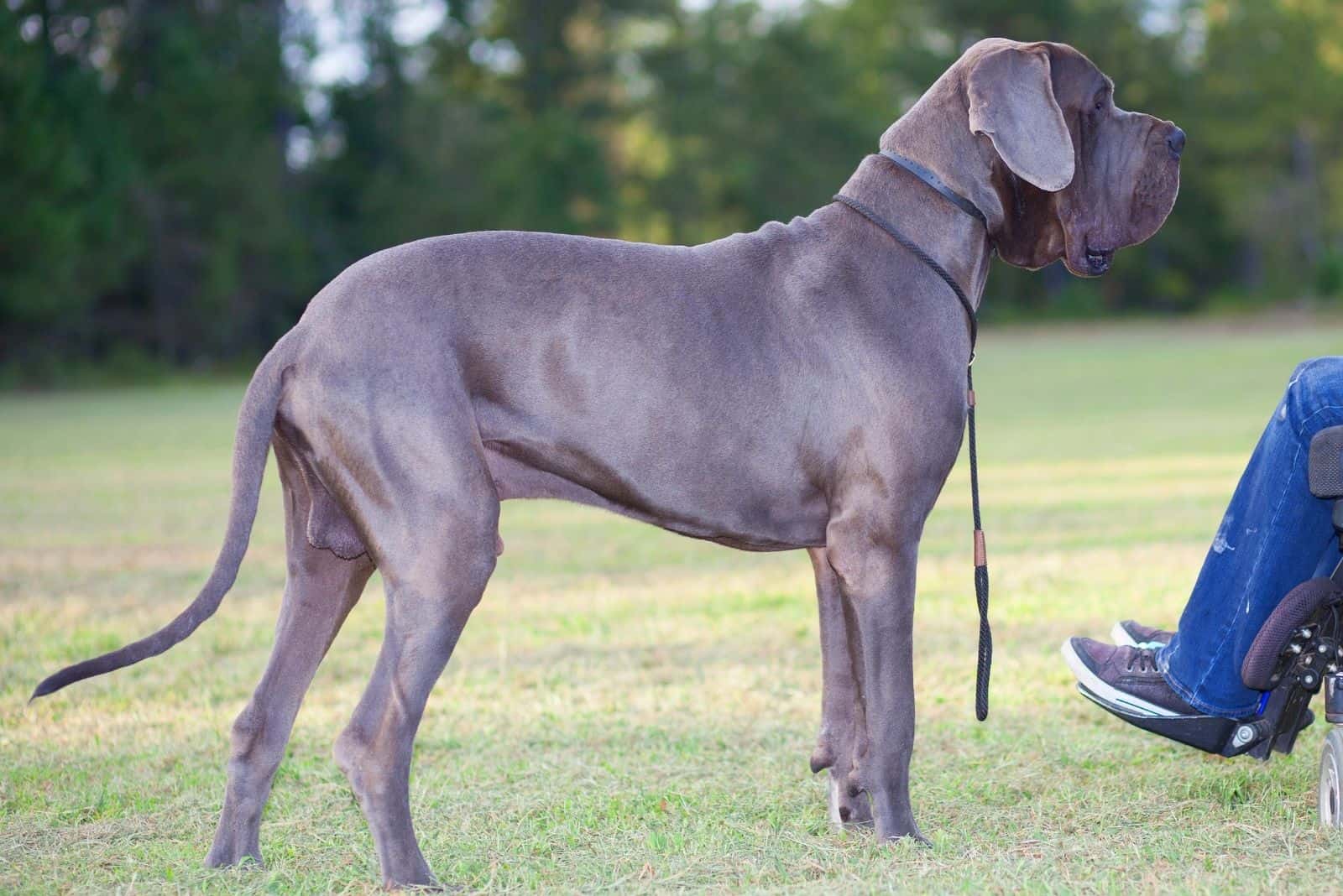
Solid blue Great Danes, as their name says, have a blue coat without markings – although some minor white markings and spots are allowed.
These dogs are the result of a dilution gene affecting solid black dogs, turning their entire coat blue.
Most blue Great Danes come in a solid color, and this is the dog most people think about when they mention the blue coat color.
Blue And White Great Dane
Blue and white Great Danes have a blue base coat with white markings. They are different from parti Great Danes, as these pups have a white base coat with blue markings.
As you might’ve guessed, these are black and white dogs with a dilution gene that has turned the black base coat into the blue one.
These dogs are not the rarest blue Great Danes, but they are far from common. Also, they are not considered a standard Great Dane color according to the AKC.
Blue Harlequin Great Dane

Photo from: @thor_theblueharlequin
Blue Harlequin Great Danes are the result of breeding a Harlequin Great Dane with a blue Great Dane. These puppies have the harlequin pattern but in the color blue.
Harlequin Great Danes have a white base coat with small, colored patches all over their body.
Harlequin Great Danes are very prized due to their rarity and beautiful looks, which only makes blue Harlequin Great Danes all the more valuable.
Blue Brindle Great Dane
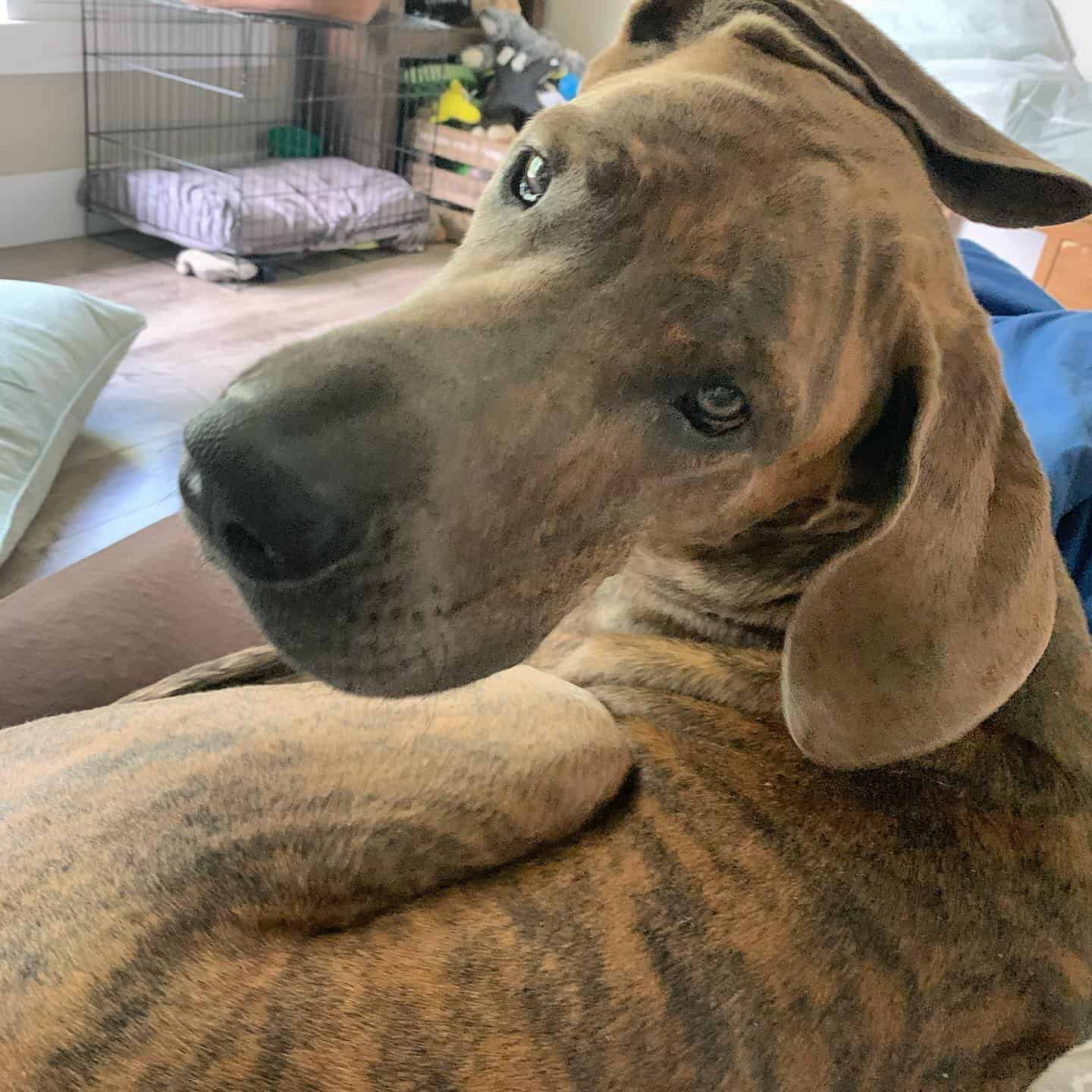
Photo from: @maeve_thedane
Blue brindle is a color combination that is not allowed within the AKC.
Brindle is not a coat color, but rather a striped pattern. You can notice it by its uniform stripe-like markings that come in a darker shade of a base color.
Standard brindle Great Danes have black stripes, but having a black coat isn’t possible in blue Great Danes. As such, blue brindle Danes have stripes that come in a darker shade of blue.
Blue Merle Great Dane

Merle is a rather unique color pattern. It can sometimes be confused with harlequin as it also has splotches of darker color on a lighter base. The biggest difference is that harlequin dogs come in white and blue, while blue merle dogs also have black markings.
This is because blue merle Great Danes aren’t products of the same blue dilution gene other blue colors are. Instead, they are the result of a specific merle gene.
Merle causes partial dilution of the pigment. This is why you can still see black spots and markings on a merle dog.
The same partial dilution might be seen on all parts of the dog’s body, such as his nose, eyes, and skin. Having a merle dog with odd-colored eyes (heterochromia) or a butterfly nose isn’t a rare sight.
Another difference is that the merle gene is dominant. This means that it only takes one allele for the merle pattern to express itself.
Blue merles are, in fact, black Great Danes with a merle gene, which has now diluted that beautiful black coat into blue, leaving some black spots.
Double Merle Trouble
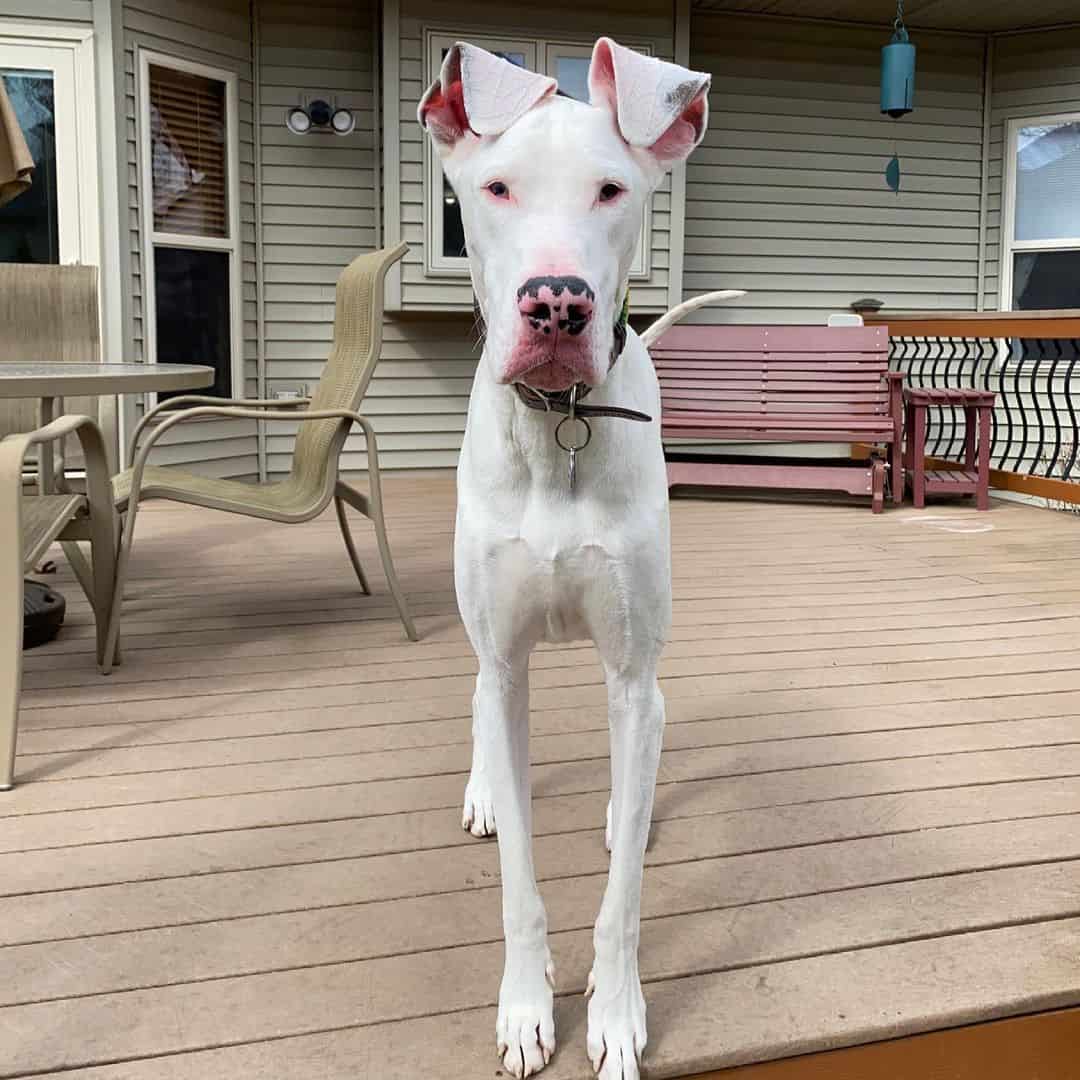
Photo from: @dingusdanes
The problem with the merle gene occurs when the dog inherits two copies of the gene – one from each of his parents.
These dogs won’t have the visible merle pattern. Instead, they’ll be in a pure white color with blue eyes or heterochromia. Some might even mistake them for albinos or white Great Danes!
The issue isn’t in a different appearance. Double merles cannot be blue, as most of the time no color will be present on them.
Instead, the problem is with the gene itself.
Merle is a very strong dilution gene. It will affect not just the dog’s coat, but all other pigments in its body, as well as the pup’s bones and heart.
It will also damage nerve ends in the dog’s ear, causing hearing problems or even deafness. Similarly, it can damage the dog’s eyes, causing blindness.
Not to mention a large number of cardiac and bone problems that come with double merles!
While merle is allowed in the Great Dane breed, the reproduction of these dogs is highly monitored. This is to make sure no two dogs with a merle gene end up mating.
This isn’t as easy as it sounds. On some dogs, known as cryptic merles, the dilution is so mild they look just like dogs in a standard color. However, they might pass the merle gene to their offspring, and if their mate is merle, the results can be catastrophic.
Blue Great Dane Temperament
Blue Great Danes have just as good temperaments as any other Great Dane might. This makes them some of the best-natured dogs you might run into.
Despite their huge size, these pups are truly gentle giants. They are affectionate and kind and they’ll love being with their owners all day long.
They are rather gentle, especially with children, making them great family pets despite their size. Still, I’d advise you to always keep an eye on your blue Great Dane during playtime with kids, as accidents might happen when you have such a large dog.
No matter the Great Dane coat color, these dogs aren’t fit for apartment living. They require lots of space and will do their best in homes with large backyards they can run into.
These pups are so friendly they’ll love everyone they get in contact with! They’ll love to share their home with many other pets and dogs and they’ll be especially fond of their owners.
In fact, they love being around humans so much they are prone to separation anxiety if left alone for too long. Separation anxiety can lead to destructive behavior, something that can be quite overwhelming when dealing with such large dogs.
While they have somewhat high energy levels, blue Great Danes will prefer spending quiet times indoors cuddling with their owners. They are not aware of their size and they’d think they can be lapdogs, something that isn’t easy when you have such a large breed.
Another thing many dog owners get surprised with is that a Great Dane isn’t the best guard dog out there. These pups will try to be friends with everyone, including strangers.
Fortunately, due to their large size, most intruders wouldn’t dare to enter a property with a blue Great Dane inside. Just don’t let them know that your big pooch would rather beg for pets than chase them off!
Blue Great Dane Lifespan
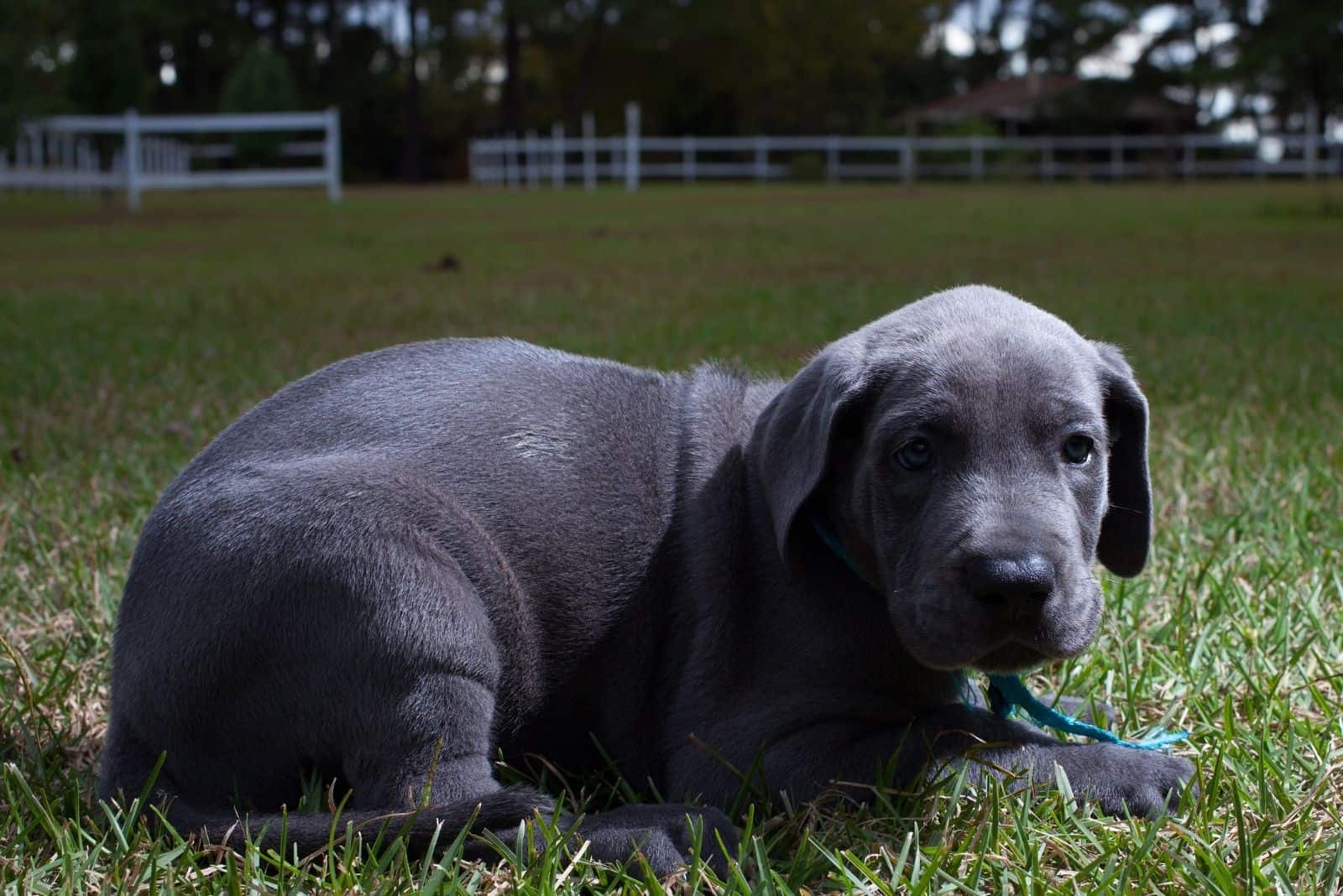
There have been some studies trying to determine whether the dilution genes have any effect on the dog’s life expectancy.
For example, it might seem that the liver dilution that causes chocolate coat color seems to slightly increase the chances of your dog developing any health condition he is already prone to.
Also, as mentioned before, merle gene is known to cause significant health problems.
As for the blue dilution gene, so far there seems to be no indication that this specific gene can lead to the increase of health problems in dogs. Blue Great Danes are just as healthy as any other Great Dane.
The only issue might happen with their eyes. Blue dilution will remove some melanin from their eyes, giving them this beautiful blue eye color these pups have.
However, blue eyes are more sensitive to the UV rays compared to darker eyes, as they have less melanin. Melanin serves as a natural protector when it comes to harmful sun rays.
Still, this difference is fairly insignificant and you probably won’t notice anything different between a dog with dark eyes and a dog with blue eyes.
While blue Great Danes are fairly healthy, they don’t have a long lifespan. Most Great Danes will live between 8 and 10 years.
However, it isn’t unheard of for Great Danes to live shorter – many die when they are only 6 years of age. A few can live longer, but almost no Great Dane has lived longer than 12 years.
One of the main reasons for such a short lifespan is the dog’s size. Larger dogs seem to always have a shorter life than smaller ones.
While the exact reason behind this isn’t known, many think it’s because large dogs grow at a faster pace. This rapid cell division is usually connected with severe health conditions – most notably, cancer.
Blue Great Dane Health Problems
No matter the coat color, Great Danes are prone to some health issues. Not all will endanger their life, but all are equally unpleasant.
Some of the health problems blue Great Danes can get include:
• Elbow and hip dysplasia: An orthopedic health condition in which the dog’s joint and hip socket aren’t properly formed.
• Cardiomyopathy: a heart disease that affects the heart muscle, making it challenging for the heart to pump blood.
• Epilepsy: A condition, usually of unknown origin, that causes seizures.
• Gastric torsion (bloat): The deadliest health problem in large dogs, it occurs when the dog’s stomach fills with gas and twists.
• Cancer: Great Danes are prone to some forms of cancer – most notably, lymphoma or lymphosarcoma, a type of cancer that attacks white blood cells.
Some of these health conditions, such as hip dysplasia, won’t lead to the death of your pooch, but they can ruin the quality of life. They require everyday medication, and if the pain gets unbearable, you might have to euthanize your pooch.
Epilepsy and cardiomyopathy usually aren’t deadly, but they might be. It all depends on the severity and whether you’re treating your pooch properly.
Gastric torsion and lymphosarcoma, however, remain the deadliest health conditions in blue Great Danes.
Cancer cannot be predicted, and it can appear in dogs that don’t have any genetic predispositions toward it. Depending on the stage, some can be treated, but many will remain deadly.
Bloat, however, requires immediate medical care. If your pooch doesn’t get treatment that might include surgery right away, death is almost certain.
Unfortunately, bloat can kill a Great Dane in a matter of hours. This health issue is one of the main reasons behind such short Great Dane lifespan.
One of the ways to reduce the chances of many of these health problems – most notably, bloat and hip dysplasia – is to feed your Great Dane with high-quality dog food and keep your pooch from being obese.
A proper diet and a healthy lifestyle can highly increase your pup’s chances of living a fairly long, happy life.
Blue Great Dane For Sale
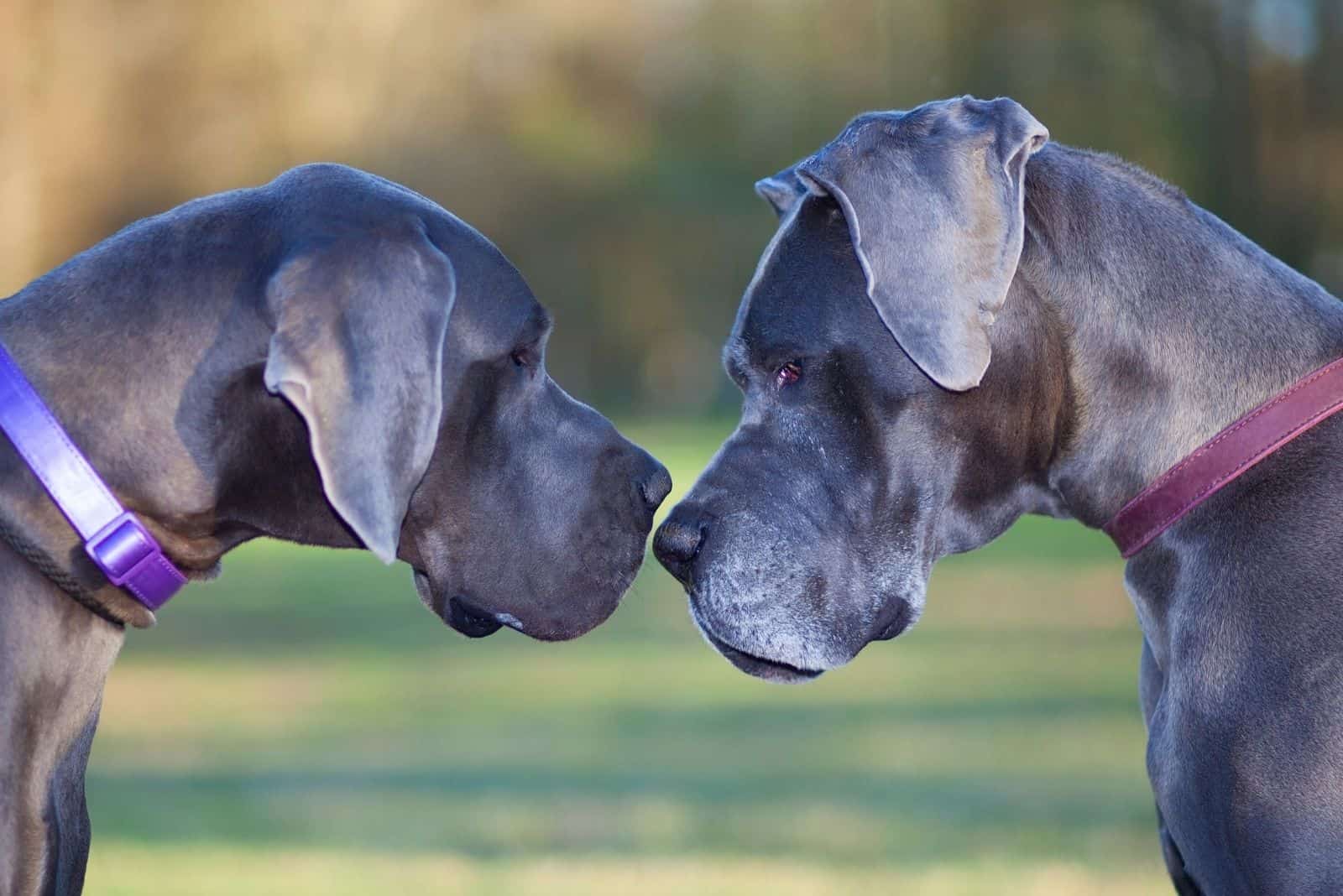
Finding blue Great Danes for sale might not be as challenging as some might expect. This isn’t such a rare color, and these pups aren’t that difficult to produce.
Still, you need to be careful with some more exotic blue patterns, such as merle or harlequin.
You can never be entirely certain whether the breeder has conducted all the necessary health screenings and whether the dog you’re buying is really healthy.
As such, always do your research and check all the references to make sure you’re getting the best pooch you possibly can.
You might also find a blue Great Dane at the rescue shelter. Many dogs end up abandoned every day, and some of them are purebred Danes.
Still, this is a rare occurrence, and you might need to wait for a while. Also, you’re likely to get an adult dog that might not have many more years to live.
Whatever the case is, adoption is always a noble choice, despite some hardships it carries.
Blue Great Dane Cost
In general, blue Great Danes don’t cost more than other Great Dane colors. You can likely find them at the standard price of $1,800 – $3,000, although you might find them at a lower cost at certain breeders.
However, there are some variations of a blue coat that can be much more expensive compared to the standard price – most notably, if they come in the harlequin pattern.
Blue harlequin Great Danes can have a high price tag. They are the rarest of the blue Great Dane colors, and this makes them rather expensive. This is because not only are black harlequin Danes rare, but it’s even rarer to find them with the blue dilution.
Even blue merles aren’t that expensive, as they are pretty standard within the breed and the color pattern.
Blue Great Dane Breeders
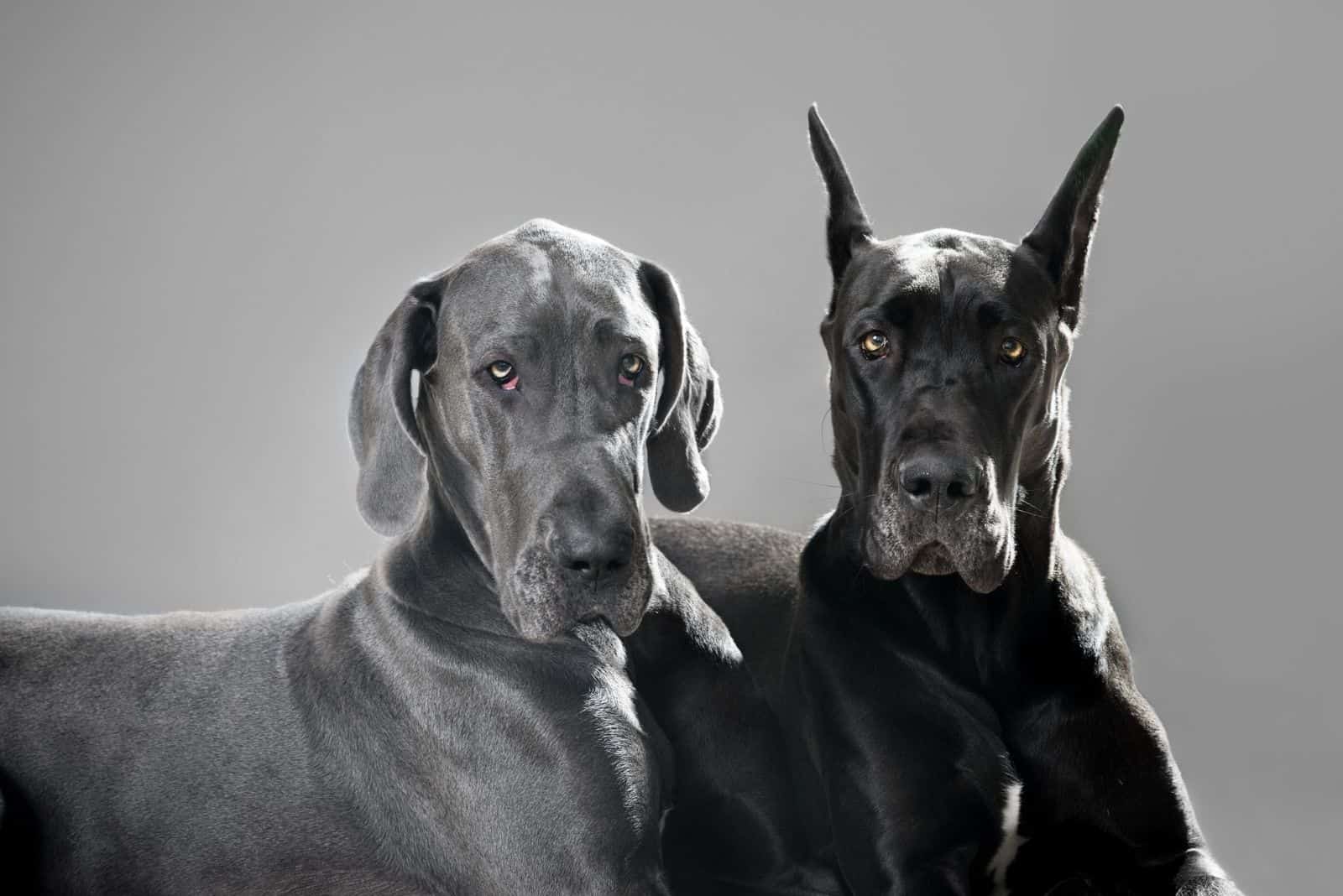
Even when you look at blue Great Danes, you might notice that not all have the same price tag. Some dogs that look the same might cost as low as $700, while others can cost several thousands of dollars.
This is because the coat color isn’t the only thing that affects the price of dogs. In fact, one thing that can affect the price much more than the pattern is the type of breeder you’re buying your dog from.
Despite how it may seem, not all breeders are the same. There are great breeders, and there are some that are not as reputable.
In general, there are three main types of breeders:
• Puppy mills.
• Backyard breeders.
• Responsible breeders.
Of course, you can choose where you buy your blue Great Dane from. However, there is a reason why I would recommend buying from only one type of breeder.
Here’s why:
Puppy Mills
As their name might suggest, puppy mills are locations that serve for breeding dogs. Their goal is to produce as many puppies in the shortest amount of time possible, so they could sell them and profit.
Profit is the main and only goal of puppy mills. They don’t really care about their dogs. In fact, most puppy mills won’t even focus on breeding blue Great Danes. These dogs will simply happen, and then they’ll sell them according to their coat color.
As such, blue Great Danes from puppy mills are usually accidental and not a result of a carefully selected breeding program.
While this might not seem important, you won’t know the background of the dogs you’re buying from puppy mills. This means you might end up with a healthy dog, or with a dog sold under the wrong label.
Many puppy mills will also sell their dogs in pet stores, which is why I am against buying dogs in such locations – although, once again, you are allowed to buy dogs from whichever breeder you want. However, it’s important to understand the risks.
You can recognize puppy mills by always having available puppies and by selling them at a rather low price – sometimes as low as $600.
Backyard Breeders
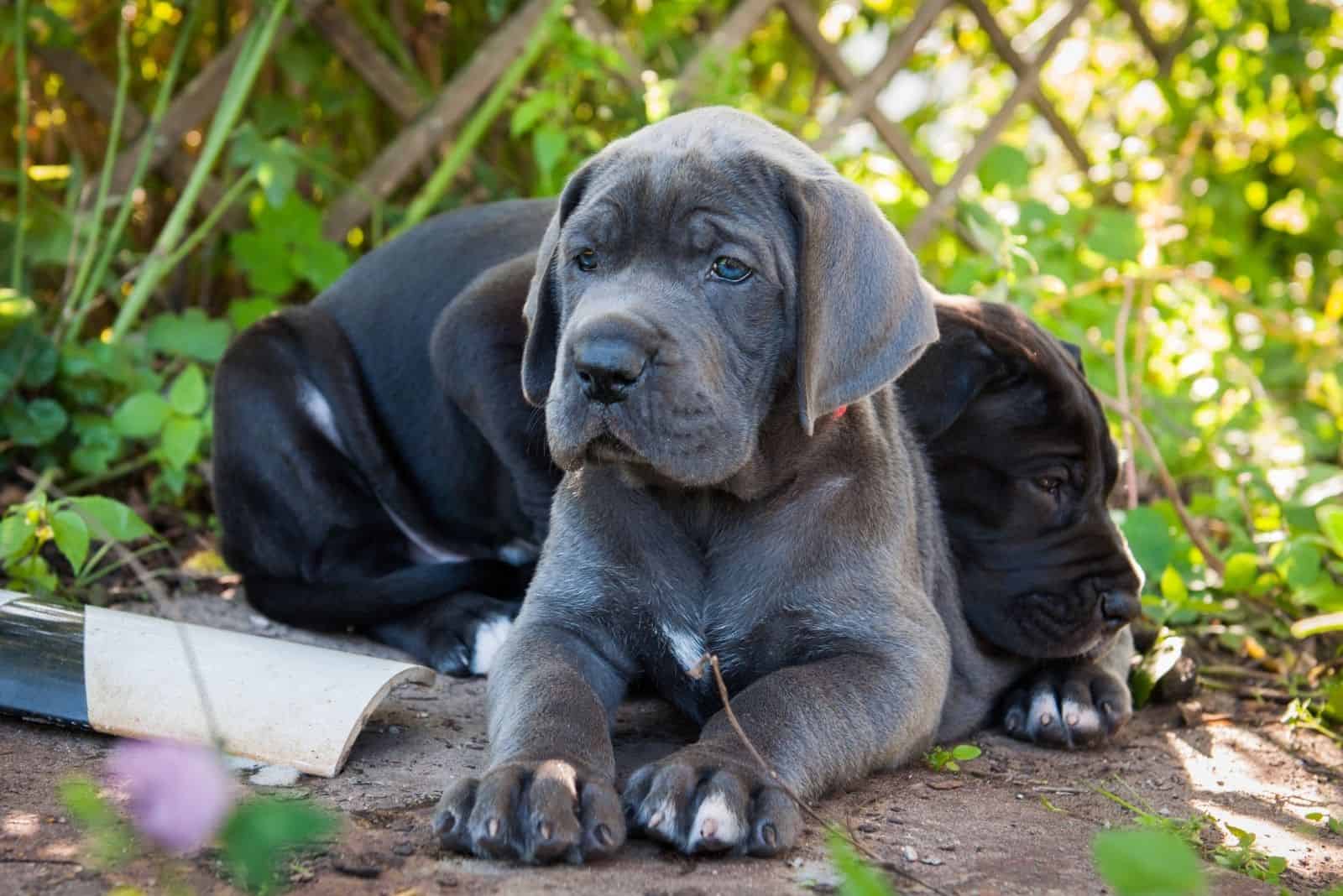
Backyard breeders breed dogs even though they don’t have the experience, knowledge, and necessary licenses.
Sometimes, these are dog owners that have ended up with a litter of blue Great Dane puppies they now want to sell, whether for profit or to find them a better home.
Other times, these are people that intentionally breed dogs wanting to sell them, but without licenses and required research.
Most backyard breeders sell their dogs online, on websites such as Craigslist. This is the best way you can locate them, as their prices can vary.
Also, most backyard breeders will sell blue Great Dane dogs without paperwork, pedigree, and health certificates.
As you might’ve guessed, this means that you’ll have no idea about the true background of your new puppy, or their health and genetics.
This is especially risky if buying blue merles, although there shouldn’t be too many issues with other blue coats.
Still, I wouldn’t advise buying from backyard breeders, as there is always the risk of buying an unhealthy dog.
Responsible Breeders
Reputable, responsible breeders are licensed breeders that follow accepted breeding practices. Most of their dogs are up to the breed standard, and their breeding stock is registered not just by kennel clubs, but also by various health organizations, such as OFA.
Reputable breeders invest a lot of money into the dogs they sell, as they consider them their family members.
They will make sure their pups are healthy by conducting various genetic testing. Sometimes, they’ll even conduct tests to see if the dogs carry the blue dilution gene, so they know precisely which dogs to pair to get this beautiful coat color.
While this means they have to sell their dogs at a high price, their dogs usually require very little investment, as they will be healthy and socialized by the time they get to your home.
When you have a dog with such a short lifespan as blue Great Danes, buying from a well-known place should be a priority. This is why I believe that the best place to buy blue Great Danes is from a responsible breeder.
Does Coat Color Matter?
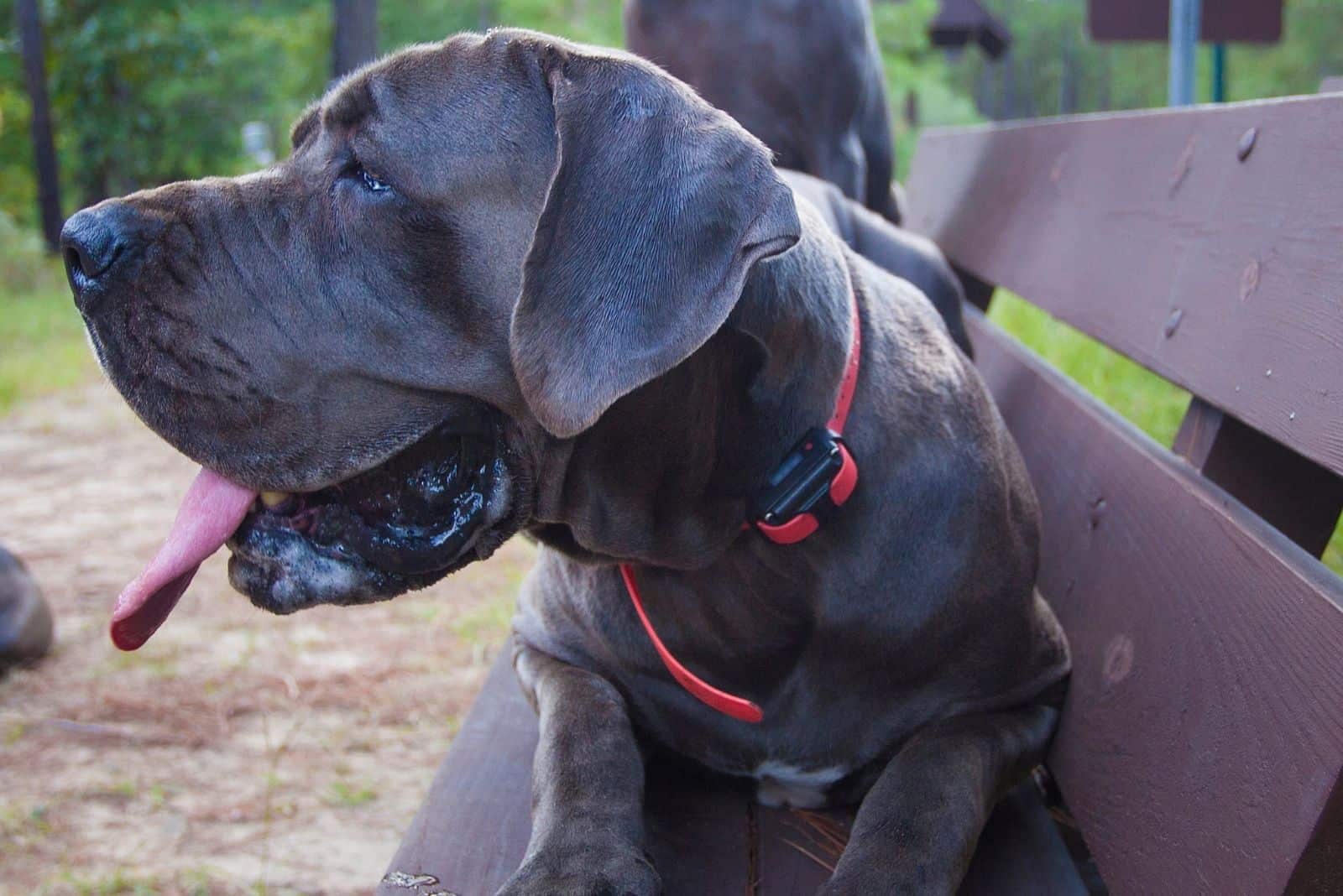
When looking at various Great Dane coat colors, you might catch yourself wondering: Does coat color matter?
The truth is, coat color matters only if your dog’s appearance is important to you. It won’t affect any other aspect of your pooch’s life in any other way.
As I’ve told you, the blue dilution gene won’t affect the Great Danes in any way. It won’t cause health problems, and it won’t change their behavior.
While there have been numerous studies trying to find out whether the coat color might affect a dog’s temperament, so far there has been no proof of this claim.
The only thing that might be argued is the lineage of the dog and its effect on the pup’s personality.
For example, blue Great Danes were mostly bred to be family pets instead of guard dogs. As such, they might be friendlier and cuddlier compared to their counterparts that don’t come in such desirable colors.
However, all of this is just an unproven theory. While you should choose a dog that looks the way you want, there really isn’t anything else that the blue coat color will affect.
Are Blue Great Danes Good Pets?
If you have a large house or a backyard and are looking for a somewhat scary-looking dog with the personality of a lapdog – congratulations! You have found the perfect dog for yourself.
Blue Great Danes are friendly, cuddly, and loyal. At the same time, they have a beautiful appearance that will leave most people breathless.
They love everyone, including kids and other pets, and they will even love strangers that come into your house uninvited!
For everyone who can provide these big dogs with everything they need, blue Great Danes can be the best family dogs out there. They prove the claims that you shouldn’t judge a book by its cover – as they are everything but large, scary dogs they appear to be.
The sad part is that they don’t live that long, and your time together might be short, especially if your pup happens to have some deadly health condition.
Despite this, if you buy from a reputable breeder and don’t skip vet checkups, your pooch can live the most of his lifespan, and he’ll make sure to make your life just a bit more beautiful while they can.
In the end, the final decision is up to you. A Great Dane might not be the dog for everyone, but they are as loveable as dogs can be. If you choose to make a blue Great Dane your new family member, I am sure you won’t regret it.















